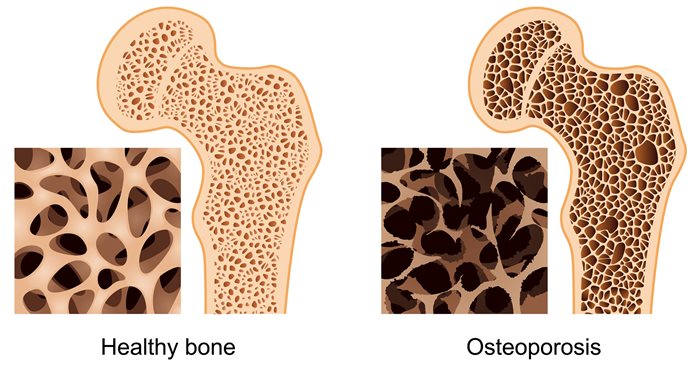Complications of osteoporosis: Osteoporosis is defined as a chronic disease in which a person loses bone mass progressively. This loss is greater than what we normally have due to ageing. Bone mass is the amount of bone that a person owns in the skeleton in a moment of life and it depends on many factors.
There is also an alteration of the bone microarchitecture. It becomes more porous, with more air inside. It augments the number and size of the cavities or cells that lie inside of it. As a consequence, the bones become more fragile so they resist the blows worse and they break with ease.
Osteoporosis can affect the entire skeleton or only certain bones.

Which are the complications?
Untreated osteoporosis follows a progressive evolution and can lead to permanent complications:
-Higher frequency of bone fractures.
-The height is reduced.
-It forms a hump (known as kyphosis).
-The pain appears due to fractures.
Bone fractures
The most common fractures due to osteoporosis are in hips, humerus, distal forearm and also in vertebrae.
The permanent pain because of fractures, related to the limited capacity of movements, can considerably harm the quality of life of patients.
Osteoporosis forces older people to seek external help. Precisely in case of multiple fractures, the elderly must go to a residence due to limitations. Pain can be limitate normal mobility in these cases.
In women with osteoporosis occurring after menopause (the so-called postmenopausal osteoporosis) complications appear in the form of vertebral fractures.
Now in the case of the so-called senile osteoporosis, which affects both sexes, fractures of the neck of the femur are very common.
In elderly people with osteoporosis, the ingravescent factor is that due to their cardiovascular diseases and slowed reaction capacity, they have more falls than when they were younger. The untrained muscles cannot stop these falls. An unprotected fall of this type often leads to osteoporosis complications (injuries and bone fractures).
Kyphosis / Decrease in height
Vertebral fractures can potentially lead to a decrease in height and an increase in dorsal kyphosis. Therefore, it is common to observe elderly individuals with osteoporosis in which the back bends and the height decrease due to vertebral fractures. In these cases, body height may decrease at a speed of 1 cm per year in the sixth and seventh decade of life.
In addition, it is relevant to know that once the first vertebral fracture occurs, there is an increased risk of vertebral fractures in the following years. Therefore, to avoid back kyphosis due to osteoporosis, it is important to prevent the appearance of the first vertebral fracture.
At the London Spine Unit, Harley Street Hospital, we have some of the best specialists to diagnose and treat osteoporosis. Book a consultation to get a checkup.

